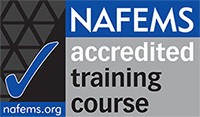| ID | Competence Statement |
| NGECkn1 | Identify the contact facilities available in a finite element system, including friction models. |
| NGECkn2 | Identify the algorithm used to follow highly nonlinear equilibrium paths in a finite element system. |
| NGECkn3 | List common categories of geometric non-linearity and contact. |
| NGECkn4 | Identify the extent to which your application software allows modification of geometric nonlinear solution parameters. |
| NGECco1 | Discuss the terms Geometric Strengthening and Geometric Weakening. |
| NGECco2 | Explain why load sequencing can give rise to different end results and identify relevant examples. |
| NGECco3 | Explain how large displacement effects can be handled as a series of linear analyses. |
| NGECco4 | Outline how large displacements, plasticity and instability can interact in a collapse scenario. |
| NGECo5 | Discuss the term Load Following. |
| NGECo7 | Contrast the terms Large Displacement and Large Strains. |
| NGECo8 | Discuss the meshing requirements for accurate contact area and contact pressure. |
| NGECo9 | Discuss the limitations of contact algorithms available in a finite element system. |
| NGECo10 | Discuss the theoretical basis of the contact algorithms available in a finite element system. |
| NGEColl | Explain the challenges of following a highly non-linear equilibrium path with both load control and displacement control. |
| NGECo12 | Contrast the Newton-Raphson method and the Riks arc-length method. |
| NGECap1 | Identify whether a system has automatic re-meshing and implement a re-meshing strategy as appropriate, due to significant distortion of a mesh. |
| NGECap3 | Carry out large strain analyses. |
| NGECap4 | Use an analysis system to carry out contact analyses. |
| NGECap5 | Conduct analyses with pre-stress and pre-strain. |
| NGECap6 | Carry out analyses with load following. |
| NGECan1 | Analyse the results from geometrically nonlinear analyses (including contact) and determine whether they satisfy inherent assumptions. |
| NGECan2 | Compare the results from geometrically nonlinear analyses (including contact) with allowable values and comment on findings. |
| NGECsy2 | Plan modelling strategies for geometrically nonlinear problems, including contact. |
| NGECev1 | Assess whether Load Following is likely to be required in any analysis. |
| NGECev2 | Select appropriate solution schemes for geometrically non-linear problems |
| NGECev3 | Assess whether element distortion effects are affecting the quality of solution and take appropriate remedial action where necessary. |
| PLASkn1 | For a beam under pure bending sketch the developing stress distribution from first yield, to collapse. |
| PLASkn7 | Sketch a stress-strain curve for an elastic-perfectly plastic and bi-linear hardening material showing elastic and plastic modulii. |
| PLASco1 | Discuss salient features of the inelastic response of metals. |
| PLASco2 | Explain the terms Isotropic Hardening, Kinematic Hardening and Rate Independency. |
| PLASco4 | Explain the terms Limit Load and Plastic Collapse Load and explain why the latter is often a misnomer. |
| PLASco10 | Discuss the effects of stress singularities at reentrant corners on limit load. |
| PLASco14 | Illustrate typical examples of Local Plastic Deformation and Gross Plastic Deformation. |
| PLASco19 | Derive the load-displacement relationship for simple two or three-bar structures with elastic-perfectly plastic materials. Repeat the derivation for elastic strain hardening materials. |
| PLASco23 | Describe the Bauschinger Effect. |
| PLASco25 | Explain why finite element solutions tend to become unstable as the limit load is approached. |
| PLASco26 | Discuss approaches employed to improve the finite element prediction of limit load. |
| PLASco27 | Explain the process of Stress Redistribution. |
| PLASco31 | Discuss the general relationship between finite element mesh and size of plastic zone. |
| PLASco37 | Describe why the incompressible nature of plastic deformation can cause difficulties with analysis. |
| PLASap7 | Using standard material data, derive a true stress vs true strain curve to be used for nonlinear analysis. |
| PLASan2 | Compare the results from nonlinear material analyses of typical pressure components with allowable values and comment on findings. |
| PLASsy1 | Specify the use of elastic perfectly plastic and bilinear or multi-linear hardening constitutive data as appropriate. |
| PLASsy3 | Plan modelling strategies for nonlinear material problems. |
| PLASev3 | Assess the significance of neglecting any feature or detail in any nonlinear material idealisation. |
| PLASev4 | Assess the significance of simplifying geometry, material models, mass, loads or boundary |
| BINkn1 | Define the term Slenderness Ratio. |
| BINkn2 | Define the term Radius of Gyration. |
| BINkn3 | Define the Determinant of a matrix. |
| BINco1 | Explain the terms Stable Equilibrium, Neutral Equilibrium and Unstable Equilibrium. |
| BINco2 | Discuss the term Load Proportionality Factor and explain what a negative value indicates. |
| BINco3 | Explain why theoretical Buckling Loads (including those calculated using FEA) often vary significantly from test values. |
| BINco4 | Explain the term Local Buckling and indicate how this can normally be prevented. |
| BINco5 | Discuss the snap-through buckling of a shallow spherical shell subjected to a lateral load and explain why a linear buckling analysis is not appropriate. |
| BINco6 | Discuss the term Post-Buckling Strength and illustrate this with examples. |
| BINco8 | Explain why symmetry should be used with caution in buckling analyses. |
| BINco10 | Explain the effects of an offset shell mid-surface on buckling. |
| BINco12 | Explain what a structural mechanism is. |
| BINco13 | Explain the meaning of Stable Buckling and provide examples. |
| BINco14 | Explain the meaning of Unstable Buckling and provide examples. |
| BINco16 | Describe the theoretical steps in a linear buckling analysis, highlighting the role of the Geometric Stiffness Matrix. |
| BINco17 | Outline various methods of extracting eigenvalues, including the Power Method. |
| BINco18 | Explain when geometric non-linear analysis should be used in a buckling analyses. |
| BINco19 | Explain the phenomenon of mode jumping. |
| BINco20 | Discuss the terms lateral buckling and flexural-torsional buckling, and provide examples of where this behaviour might arise. |
| Binco23 | Discuss the characteristics of thin-walled structures that could influence buckling behaviour. |
| BINap1 | Use tables to evaluate Euler buckling loads for common configurations of columns, plates and shells. |
| BINap2 | Conduct eigenvalue buckling analyses. |
| BINap3 | Conduct post-buckling analyses. |
| BINan1 | Compare FEA results with buckling and instability tests and justify conclusions. |
| BINan2 | Analyse the results from buckling and instability analyses of typical pressure components and determine whether they satisfy code requirements. |
| BINsy1 | Plan modelling strategies for buckling of stiffened plate/shell structures. |
| BINsy2 | Plan modelling strategies for plate/shell structures with an offset in midsurface. |
| BINsy3 | Plan a series of simple benchmarks in support of a more complex instability analysis. |
| BINsy4 | Plan modelling strategies for buckling and instability problems. |
| BINsy5 | Prepare an analysis specification for buckling and instability analyses, including modelling strategy, highlighting any assumptions relating to geometry, loads, boundary conditions and material properties. |
| BINev1 | Assess the possibility of local and global buckling from the results of a non-buckling analysis. |
| BINev2 | Select appropriate idealisation(s) for a buckling analysis. |
| BINev3 | Assess whether a non-linear buckling analysis is necessary. |
| BINev4 | Select appropriate solution schemes for buckling problems. |
| BINev5 | Assess the significance of neglecting any feature or detail in any buckling idealisation. |
| CTDkn6 | State the basic definitions of stress relaxation and creep. |
| CTDco1 | Describe and illustrate a standard creep curve for steels, highlighting the steady state regime. |
| CTDco2 | Using the standard creep curve, describe the effects of (i) increasing stress level and (ii) removing the stress. |
| CTDco3 | Describe different ways of presenting creep data. |
| CTDco7 | Explain, in general terms, the creep solution process as typically implemented in finite element systems. |
| MASco7 | Describe the following constitutive behaviour for materials relevant to your industry sector: hyperelastic, viscoelastic, viscoplastic. |
| MASco18 | Describe the effects of strain rate (if any) on the behaviour of materials used in products within your organisation. |





